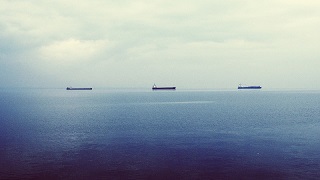
A highly unusual and exceptional event occured yesterday June 13th 2019, at the Gulf of Oman - an attack on two oil tankers during daylight: something which has not taken place since the "Tanker War" of the Iran-Iraq Conflict in the 1980s. The oil price had immediately surged 4% on the news, with fears of further regional destabilization of oil routes. The hydrocarbon shipping via the targeted region is of utmost importance, bringing massive amounts of oil and other liquids from the Persian Gulf countries to southern and eastern Asia, as well as Europe. This was the second attack on tankers this year in the Omani Gulf, the previous taking place one month earlier.
Previously an attack on oil tankers had taken place exactly one month earlier, when 4 tankers were sabotaged with marine mines in the same area offshore the UAE Port of Fujairah. Those tankers belonged to Saudi Arabia, UAE and Norway. The May incident in the Gulf of Oman was concluded to likely be a commando operation by a "state-level entity". The investigation into May incident highlighted the rising Iranian-Saudi tensions in the region and throughout the Middle East, with increasing pressure of the United States against Iran and its interests.
Now, US immediately accused Iran of the 2nd tankers incident. However, Iran denied and indicated that the tankers were carrying oil to Japan and the incident took place during the official visit of the Japanese Prime-Minister Sinzo Abe to the Republic of Iran, making Iran a convenient but unlikely side to blame. Iran further indicated it even assisted in crew evacuation, but US called this claim a "complete lie". In any case, the crews of the two tankers had been evacuated, with one of them significantly damaged and burning. According to initial reports, one of the tankers was hit with a torpedo, whereas another unspecified.
However, what is obvious is that Middle East tanker incidents bring havoc to oil supply routes. Though not immediately clear on its identity, the party behind those incidents might have a clear interest in volatile oil prices or alternatively in enhancing the price of tanker shipping insurance. The Omani Gulf concentrates both the shipping from the Strait of Hormuz and the deep water Fujairah port of the UAE - remarkably established back in 1983 in order to bypass the Strait of Hormuz, where at the time tankers were targeted by Iranian military upon the Iran-Iraq War. The Strait of Hormuz has an estimated shipping capacity of 17-18 million barrels of oil and liquids per day, while the Fujairah port adds another 2 million. Altogether, the Gulf of Oman is a hub for about 20% of global trade in oil and hydrocarbon liquids and as much as 30% of global marine trade in this segment. The oil shipping in this area is hence of strategic importance to oil producers in the Persian Gulf, oil consumers and even indirectly involved parties and powers who are dependent on global oil prices such as United States and Russia.







